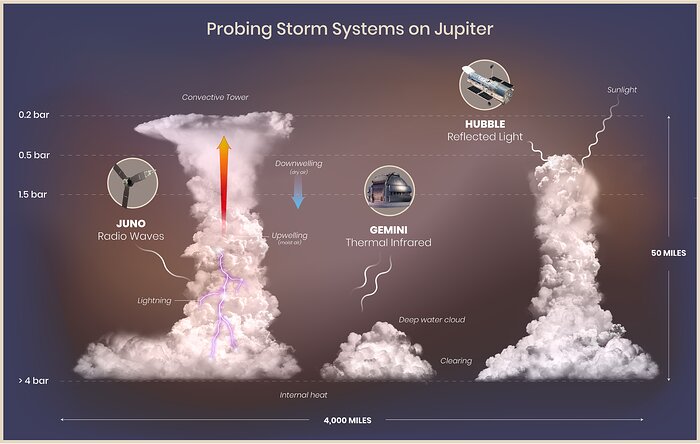Ilustración de la estructura de nubes
Esta ilustración de rayos, torres convectivas (nubes de tormentas), nubes profundas de agua y claros en la atmósfera de Júpiter, están basados en datos recopilados por la sonda espacial Juno, el Telescopio Espacial Hubble y el Observatorio internacional Gemini. Juno detecta las señales de radio generadas por las descargas de los rayos. Como las ondas de radio pueden atravesar las capas de nubes de Júpiter, Juno es capaz de detectar rayos en nubes muy profundas, así como también los rayos en el lado diurno del planeta. Hubble detecta la luz solar que se refleja en las nubes de la atmósfera de Júpiter. Diferentes longitudes de onda penetran a diferentes profundidades en las nubes, dando a la investigadores la habilidad de determinar la altura relativa de la cima de las nubes. Gemini mapea el grosor de las nubes frías que bloquean la luz infrarroja térmica de las capas atmosféricas más cálidas que están por debajo de las nubes. Las nubes gruesas se ven oscuras en los mapas infrarrojos, mientras que los claros aparecen brillantes. La combinación de observaciones pueden ser utilizadas para mapear la estructura de nubes en tres dimensiones e inferir detalles de la circulación atmosférica. Nubes gruesas e imponentes se forman donde el aire húmedo se eleva (surgencia y convección activa). Se forman claros donde se hunde el aire más seco (bajando). Las nubes que se muestran, se elevan cinco veces más alto que las torres convectivas similares que hay en relativamente poco profunda atmósfera de la Tierra. La región ilustrada cubre un tramo horizontal que es un tercio más grande que los Estados Unidos continentales.
Créditos:NASA, ESA, M.H. Wong (UC Berkeley), and A. James and M.W. Carruthers (STScI)
About the Image
| Id: | noirlab2011c |
| Idioma: | es |
| Tipo: | Artwork |
| Release date: | 7 de Mayo de 2020 a las 03:00 |
| Related releases: | noirlab2011 |
| Size: | 2143 x 1360 px |
Sobre el Objeto
| Categoría: | Solar System |
